上海交通大学:《生物传热学教与学 Bioheat Transfer》课程教学资源(电子讲义)lecture 3 Apply Energy Conservation Equation

Lecture 3 Apply Energy Conservation Equation
Lecture 3 Apply Energy Conservation Equation
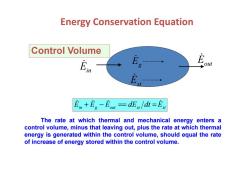
Energy Conservation Equation Control Volume out E st En+E。-Eom=dEu/dt=Et The rate at which thermal and mechanical energy enters a control volume,minus that leaving out,plus the rate at which thermal energy is generated within the control volume,should equal the rate of increase of energy stored within the control volume
Energy Conservation Equation in g out st Est E E E dE dt + − == = The rate at which thermal and mechanical energy enters a control volume, minus that leaving out, plus the rate at which thermal energy is generated within the control volume, should equal the rate of increase of energy stored within the control volume. Control Volume Ein Eout E g Est

Procedure: Define appropriate control volume with the control surface ldentify appropriate time basis Identify relevant energy processes Write conservation equation
Procedure: • Define appropriate control volume with the control surface • Identify appropriate time basis • Identify relevant energy processes • Write conservation equation
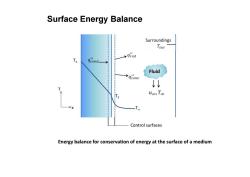
Surface Energy Balance Surroundings Tsur 9gaa qcond Fluid qconv ↓ T uoo,To Control surfaces Energy balance for conservation of energy at the surface of a medium
Surface Energy Balance T1 T2 T x T ∞ Control surfaces Fluid Energy balance for conservation of energy at the surface of a medium

Ein-Eout =0 Conduction from the medium to the control surface Qcond Convection from the surface to a fluid qconv Net radiation exchange from the surface to the surroundings qrad Energy Balance: qcond -qconv -qrad =0
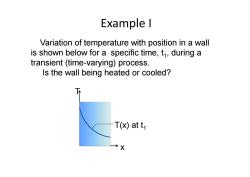
Example I Variation of temperature with position in a wall is shown below for a specific time,t1,during a transient(time-varying)process. Is the wall being heated or cooled? T(x)at t X
Variation of temperature with position in a wall is shown below for a specific time, t 1, during a transient (time-varying) process. Is the wall being heated or cooled? T x T(x) at t 1 Example I

Example 2 The power supplied to a heating pad which measures 1cm*1cm is 0.02w.The pad is mounted the surface of human surface (a flat plate)and is allowed to exchange heat by free convection to the surrounding air at 26C.The heat transfer coefficient for this configuration is 8 w/m2.C.Safety considerations require that the surface temperature not exceed 45C.Should the heating be operated under these conditions?
Example 2 • The power supplied to a heating pad which measures 1cm*1cm is 0.02w. The pad is mounted the surface of human surface (a flat plate) and is allowed to exchange heat by free convection to the surrounding air at 26oC. The heat transfer coefficient for this configuration is 8 w/m2·oC. Safety considerations require that the surface temperature not exceed 45oC. Should the heating be operated under these conditions?
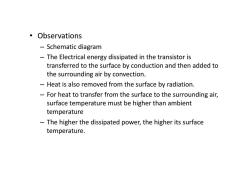
·Observations Schematic diagram The Electrical energy dissipated in the transistor is transferred to the surface by conduction and then added to the surrounding air by convection. Heat is also removed from the surface by radiation. -For heat to transfer from the surface to the surrounding air, surface temperature must be higher than ambient temperature The higher the dissipated power,the higher its surface temperature
• Observations – Schematic diagram – The Electrical energy dissipated in the transistor is transferred to the surface by conduction and then added to the surrounding air by convection. – Heat is also removed from the surface by radiation. – For heat to transfer from the surface to the surrounding air, surface temperature must be higher than ambient temperature – The higher the dissipated power, the higher its surface temperature
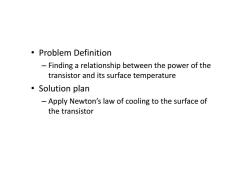
·Problem Definition Finding a relationship between the power of the transistor and its surface temperature 。Solution plan Apply Newton's law of cooling to the surface of the transistor
• Problem Definition – Finding a relationship between the power of the transistor and its surface temperature • Solution plan – Apply Newton’s law of cooling to the surface of the transistor
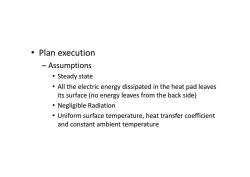
。Plan execution -Assumptions ·Steady state All the electric energy dissipated in the heat pad leaves its surface(no energy leaves from the back side) Negligible Radiation Uniform surface temperature,heat transfer coefficient and constant ambient temperature
• Plan execution – Assumptions • Steady state • All the electric energy dissipated in the heat pad leaves its surface (no energy leaves from the back side) • Negligible Radiation • Uniform surface temperature, heat transfer coefficient and constant ambient temperature
按次数下载不扣除下载券;
注册用户24小时内重复下载只扣除一次;
顺序:VIP每日次数-->可用次数-->下载券;
- 上海交通大学:《生物传热学教与学 Bioheat Transfer》课程教学资源(电子讲义)lecture 2 Energy and Energy Transfer.pdf
- 上海交通大学:《生物传热学教与学 Bioheat Transfer》课程教学资源(电子讲义)Lecture 27 Thermal conductivity, Blood Perfusion Measurement.pdf
- 上海交通大学:《生物传热学教与学 Bioheat Transfer》课程教学资源(电子讲义)Lecture 26:Cryosurgery.pdf
- 上海交通大学:《生物传热学教与学 Bioheat Transfer》课程教学资源(电子讲义)lecture 24&25 Cryobiology、Cryopreservation.pdf
- 上海交通大学:《生物传热学教与学 Bioheat Transfer》课程教学资源(电子讲义)lecture 23 Dynamic Vascular Response.pdf
- 上海交通大学:《生物传热学教与学 Bioheat Transfer》课程教学资源(电子讲义)Lecture 20 Introduction to FLUENT.pdf
- 上海交通大学:《生物传热学教与学 Bioheat Transfer》课程教学资源(电子讲义)lecture 1 Introduction(张爱丽).pdf
- 上海交通大学:《生物传热学教与学 Bioheat Transfer》课程教学资源(电子讲义)lecture 19&21 Modeling in thermal treatment——heating.pdf
- 上海交通大学:《生物传热学教与学 Bioheat Transfer》课程教学资源(电子讲义)lecture 17&18 Hyperthermia treatment for tumors.pdf
- 上海交通大学:《生物传热学教与学 Bioheat Transfer》课程教学资源(电子讲义)Lecture 16 Temperature Measurement Jianqi Sun.pdf
- 上海交通大学:《生物传热学教与学 Bioheat Transfer》课程教学资源(电子讲义)lecture 15_lecture 15-vasculature.pdf
- 上海交通大学:《生物传热学教与学 Bioheat Transfer》课程教学资源(电子讲义)Lecture 15:Anatomy and Description of Microvasculature.pdf
- 上海交通大学:《生物传热学教与学 Bioheat Transfer》课程教学资源(电子讲义)Lecture 14:Two methods to solve differential equation.pdf
- 上海交通大学:《生物传热学教与学 Bioheat Transfer》课程教学资源(电子讲义)lecture 12&13 Bioheat transfer Equations.pdf
- 上海交通大学:《生物传热学教与学 Bioheat Transfer》课程教学资源(电子讲义)Lecture 11 Radiation Continued.pdf
- 上海交通大学:《生物传热学教与学 Bioheat Transfer》课程教学资源(电子讲义)Lecture 10:Radiation.pdf
- 上海交通大学:《生物工程导论》课程教学资源_果蝇 Fruit Fly.ppt
- 上海交通大学:《生物工程导论》课程教学资源_生物学领域经典网站.doc
- 《工业微生物》:我国生物发酵产业发展现状及发展趋势(中国生物发酵产业协会).pdf
- 上海交通大学:《生物工程导论》课程教学资源(阅读资料)工业生物技术产业发展趋势及对我国的启示.pdf
- 上海交通大学:《生物传热学教与学 Bioheat Transfer》课程教学资源(电子讲义)lecture 4 Heat Conduction Equation.pdf
- 上海交通大学:《生物传热学教与学 Bioheat Transfer》课程教学资源(电子讲义)lecture 5.1 Conduction equation and examples.pdf
- 上海交通大学:《生物传热学教与学 Bioheat Transfer》课程教学资源(电子讲义)lecture 5.2 Conduction equation and examples.pdf
- 上海交通大学:《生物传热学教与学 Bioheat Transfer》课程教学资源(电子讲义)lecture 6 Thermal Resistance Method.pdf
- 上海交通大学:《生物传热学教与学 Bioheat Transfer》课程教学资源(电子讲义)lecture 7 Convection.pdf
- 上海交通大学:《生物传热学教与学 Bioheat Transfer》课程教学资源(电子讲义)lecture 8 Heat Transfer to Blood Vessels.pdf
- 上海交通大学:《生物传热学教与学 Bioheat Transfer》课程教学资源(电子讲义)lecture 1 Introduction.pdf
- 上海交通大学:《生物传热学教与学 Bioheat Transfer》课程教学资源(电子讲义)lecture 10 anatomy of vasculature and dynamic blood flow.pdf
- 上海交通大学:《生物传热学教与学 Bioheat Transfer》课程教学资源(电子讲义)lecture 11 Measurement of Thermal Properties for biological tissue.pdf
- 上海交通大学:《生物传热学教与学 Bioheat Transfer》课程教学资源(电子讲义)lecture 12 Hyperthermia treatment for tumors.pdf
- 上海交通大学:《生物传热学教与学 Bioheat Transfer》课程教学资源(电子讲义)lecture 2 Energy and Energy Transfer.pdf
- 上海交通大学:《生物传热学教与学 Bioheat Transfer》课程教学资源(电子讲义)lecture 3 Energy and Energy Conservation.pdf
- 上海交通大学:《生物传热学教与学 Bioheat Transfer》课程教学资源(电子讲义)lecture 4 Solve of the Conduction Eq..pdf
- 上海交通大学:《生物传热学教与学 Bioheat Transfer》课程教学资源(电子讲义)lecture 5-6-1 convection and blood flow convection-web.pdf
- 上海交通大学:《生物传热学教与学 Bioheat Transfer》课程教学资源(电子讲义)lecture 5 Convection.pdf
- 上海交通大学:《生物传热学教与学 Bioheat Transfer》课程教学资源(电子讲义)lecture 7 Radiation Between Surfaces.pdf
- 上海交通大学:《生物传热学教与学 Bioheat Transfer》课程教学资源(电子讲义)lecture 8 bioheat transfer equation-1.pdf
- 《生物学通报》:microRNA及其与衰老进程的关系(北京大学衰老研究中心:姜彬).pdf
- 《遗传学与社会》课程教学资源:性别决定基因的研究进展(南京铁道医学院).pdf
- 《遗传学与社会》课程教学资源:性别决定的分子机制.pdf
